Our projects
Group 1: Humans in their Ancient Urban and Natural Environments
Associated Projects
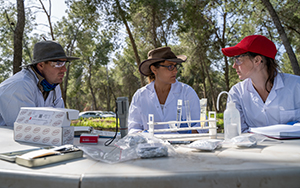 Postdoctoral Fellowship in the Archaeology of Ancient Israel
Postdoctoral Fellowship in the Archaeology of Ancient Israel
Dr Sophia Aharonovich (Department of History and Archaeology)
During her Postdoctoral Research Fellowship, Sophia is planning to work on forensic analysis of biblical period sediments and pottery analysing organic residue, pollen grains and phytoliths. She will use her research to bring some taste, smell and colour to daily life in the biblical period. Her three-year postdoctoral fellowship is fully funded by the Education Heritage Foundation.
See Sophia's profile.
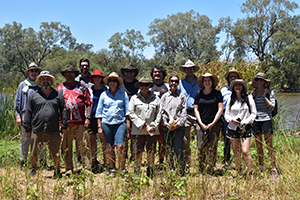
Dr Emily O’Gorman (Geography and Planning, Macquarie School of Social Sciences), Uncle Phil Duncan (Alluvium), A/Prof. Fiona Miller (Geography and Planning, Macquarie School of Social Sciences), A/Prof. Sandie Suchet-Pearson (Geography and Planning, Macquarie School of Social Sciences), Dr Jess McLean (Geography and Planning, Macquarie School of Social Sciences), A/Prof. Bradley Moggridge (University of Canberra), Prof. Ross Thompson (University of Canberra)
Gomeroi/Kamilaroi Country on NSW's north-west slopes and plains, in the north-west of the Murray-Darling Basin, has experienced severe degradation over the last 100+ years due to intensive agriculture, grazing, and associated water management regimes. Current climate changes are exacerbating these impacts as droughts become longer, floods and heat extremes more intense, and climatic zones shift, impacting on species’ viability and biodiversity. Through two successive On-Country Classrooms, this project will support transformative education programs that enable Gomeroi/Kamilaroi custodians and youth, environmental experts, management authorities and tertiary students (planning, geography, and science), to learn with and from each other and improve Indigenous/non-Indigenous collaboration for climate change mitigation and adaptation in NSW.
Image: The research team with other participants of the 2019 on-Country workshop, Gwydir wetlands, Gomeroi/Kamilaroi Country, NSW, Australia. Photo: S. Suchet-Pearson.
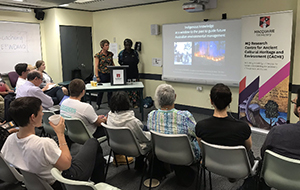 Exploring the Past with Data
Exploring the Past with Data
Prof. Ronika Power (Department of History and Archaeology), Dr Rowan McLaughlin (Queen's University Belfast, Northern Ireland & Institut Català de Paleoecologia Humana, Spain)
This workshop explored new data-driven methods in archaeology and history that unravel patterns in the data and provided fresh insight into the powerful but sometimes hidden forces that shape society.
See associated workshop: Exploring the Past with Data (November 2019).
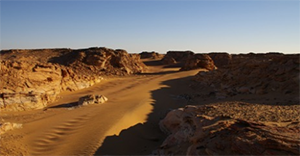 Human Adaptation to the Environment
Human Adaptation to the Environment
Dr Fred Hartdke (Department of History and Archaeology), Dr Heiko Riemer (Universität zu Köln)
This event will consider how humans in ancient times were able to survive in, but at the same time exploit, deserts and arid environments.
See associated symposium: Humans in Deserts - Stories of Exploration and Survival (November 2020).
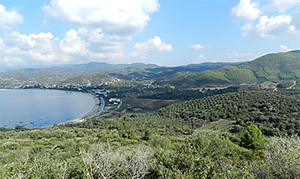 A Geophysical Exploration of Ancient Torone in the Chalkidike
A Geophysical Exploration of Ancient Torone in the Chalkidike
A/Prof. Lea Beness (Honorary Associate Professor, Department of History and Archaeology), et al.
A transdisciplinary project aiming to map the current subsurface profile of Torone's ancient shoreline and possible harbour installations.
Group 2: Receptions of Ancient Cultural Heritage
Associated Projects
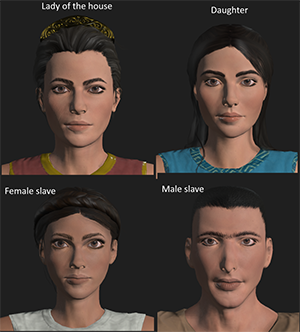 Greek Villa Project
Greek Villa Project
Dr Susan Lupack (Department of History and Archaeology), Prof. Bronwen Neil (Department of History and Archaeology), Prof. Deborah Richards (Department of Computing), A/Prof. Ayse Bilgin (Department of Mathematics and Statistics)
Commenced S2 2019. Ancient historians Susan Lupack and Bronwen Neil have collaborated with Deborah Richards and Ayse Bilgin to map a virtual reality Greek Villa, which we presented in the Simulation Hub for the students of AHIS2302: Archaeology and Society.
Our aim in creating the Villa was to bring to life certain aspects of ancient daily living for students, as well as more intangible aspects, such as gendered work and the status of slaves. The students took on the avatar of a fifteen-year old slave girl entering the villa for the first time, where they met and had dialogues with three different characters: the mistress of the household, the head female slave, and the head male slave.
The initial impetus for this project was to compare the effectiveness of immersive learning experiences with traditional lecture and text-based student learning, and we are currently analysing the results of the quizzes taken by students after the experience. This research will form the basis of a multi-authored article. The team have also been discussing how we can make this Greek Villa available on a wider scale for audiences outside of Macquarie.
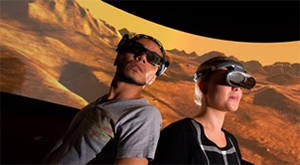 Living Digital Heritage
Living Digital Heritage
Dr Fred Hartdke (Department of History and Archaeology)
This conference will present the latest in high-tech approaches to heritage preservation and understanding and showcase how Australian researchers are at the leading edge of technology applications to heritage management.
See associated conference: Living Digital Heritage (November 2021).
Ancient Egyptian Papyri: Unlocking Secrets to the History of Writing (ARC DP 2019–2021)
Prof. Malcolm Choat (Department of History and Archaeology), Prof. Damian Gore (Department of Earth and Environmental Sciences), Dr Rodney Ast (Universität Heidelberg)
This project aims to investigate the chemical composition of papyri from ancient Egypt and their inks to identify scribes, date texts, detect forgeries, match fragmentary texts, and illuminate environmental and technological change.
See the associated website: Forging Antiquity.
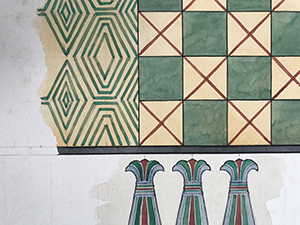 Antiquity in the Archive: Rediscovering Beni Hassan in the Griffith Institute Archive, Oxford University
Antiquity in the Archive: Rediscovering Beni Hassan in the Griffith Institute Archive, Oxford University
Dr Alex Woods (Department of History and Archaeology), Dr Nicolle Leary (Department of History and Archaeology), Dr Julia Hamilton (Department of History and Archaeology) and Sara Hany Abed
This collaborative project between the Griffith Institute Archive (GIA), University of Oxford, and Macquarie University will digitally document, catalogue, index and contextualise the 260 archive materials captured during the Egypt Exploration Fund’s late 19th century survey of the ancient cemetery of Beni Hassan in Egypt. The project aims to theorise and critique the development of an archaeological archive using the process of digitising Beni Hassan material in the GIA as a case study. Instead of viewing the archive as a source of documentation on Beni Hassan in Egypt, the project will view the archive as "subject", treating the documentation as historical artefacts with complex conditions of production and as colonial or institutional instruments. Digitising the archive will make the content widely available to researchers and the public as an online resource, provide a valuable store of knowledge and in turn publicise the archive's cultural legacy.
Image: Photograph of a mounted watercolour. Drawn and measured on site by John E. Newberry, January 1893. The watercolour depicts a representative sample of the frieze and geometric pattern in the barrel-vault ceiling in the tomb of Khnumhotep II, Tomb 3, Beni Hassan, Egypt (GI-WD-scenes-100). From the collection of the Griffith Institute Archive, University of Oxford. Reproduced with permission of The Griffith Institute, University of Oxford. Photo: A. Woods. © The Griffith Institute, University of Oxford. All rights reserved.
Group 3: Ancient Models of Leadership: Learning from the Past
Associated Projects
Crises of Leadership in the Eastern Roman Empire (250–1000 CE) (ARC DP 2020–2022)
A/Prof. Eva Anagnostou-Laoutides (Department of History and Archaeology), Dr Peter Edwell (Department of History and Archaeology), Prof. Bronwen Neil (Department of History and Archaeology), Prof. Theodore de Bruyn (University of Ottawa), Dr Matthew O'Farrell (Department of History and Archaeology), Dr Phoebe Garrett (Department of History and Archaeology)
Late-antique Roman societies from the mid-third to the tenth centuries had a morbid fascination with the “End of Days”, and more importantly, determining their futures in the face of various kinds of crisis, whether political, environmental or religious. Such crises offered an opportunity for a different kind of leadership, one that claimed direct access to the gods or later, to God. The interdisciplinary team of investigators compares the strategies used by citizens of the eastern Roman empire to express dissent and dissatisfaction to their leadership, including emperors and church leaders. They compare those leaders’ rhetorical and practical responses to (a) internal dissent; (b) foreign aggressors; (c) neighbouring cultures with different religious identities. By analysing first-millennium sources and their millennial concerns, our twin aims are:
- To retrieve the use of social critique and morality for and against models of political leadership in apocalyptic discourses of the later eastern Roman empire; and
- To generate models of religious responses by leaders and citizens to crisis that may help Australian community leaders to understand and manage similar crises in the present.
From Where the Fine Warships Come: Democratic Athens at War (ARC DP 2020–2022)
Prof. Ian Worthington (Department of History and Archaeology), A/Prof. David Pritchard (University of Queensland)
The book will address makers of strategy and leaders in modern warfare as well as the regular academic audience and (enigmatic) interested general public. The book is co-written with Cpt. M. Ferguson of the U.S. Army, a former combat veteran now in military intelligence, with the participation of Gen. H.R. McMaster (U.S. Army retired and former N.S.A. to President Donald Trump). It sets the lessons to be learned from the successes and failures of Alexander’s leadership, command skills, and grand strategy amidst the backdrop of 21st century challenges, specifically, the human aspect versus the mechanical. Alexander’s reign is used as a vehicle to demonstrate the centrality of dynamic leadership in our age of lethal autonomous weapons systems and artificially intelligent machines. Rather than relieving the burden of ambiguity and decision-making from tomorrow’s leaders, these disruptive emerging technologies are more likely to make effective leadership that much more challenging. The study of Alexander’s persona amidst his many successes and tragic failures is therefore more important than ever before; its lessons stress the need for the human aspect of generalship, statesmanship, and grand strategy in a digital era awash with technological and operational change.
See associated book project: Ian Worthington and Michael Ferguson, The Leadership of Alexander the Great: What the 21st Century Needs to Know.
The Macquarie Dictionary of Roman Biography Project
A/Prof. Lea Beness (Honorary Assistant Professor, Department of History and Archaeology), A/Prof. Tom Hillard (Honorary Assistant Professor, Department of History and Archaeology)
The initial product, following a set of detailed studies many of which are already in print, will be a preliminary volume A Dictionary of Roman Social and Political Biography 168–111 BC, comprising approximately 1500 entries embracing all known bearers of Roman citizenship in that period, together with members of their familiae. The format is prosopographical; the focus political, social and cultural. The broader objective is the interrogation of the nature of Roman leadership at a time when the imperial Republic, in the process of transforming the Mediterranean world, was itself being transformed by that process, and to shed light on the dynamics of that broader transformation. Underlying these foci is an interest in the role of human agency in the generation, and management, of change.
